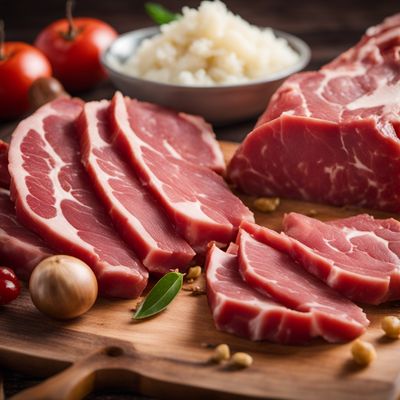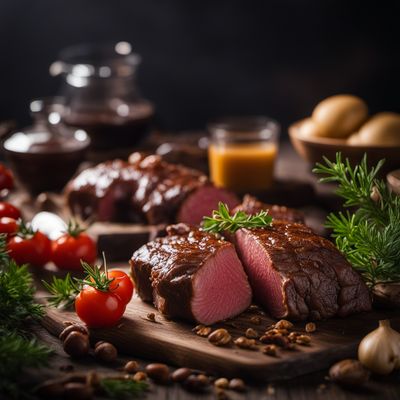
Ingredient
Wapiti elk meat
The Majestic Delicacy: Wapiti Elk Meat
Wapiti elk meat comes from the North American elk, also known as wapiti, and is highly regarded for its distinct flavor, which is often described as rich, earthy, and slightly sweet. It has a tender texture and is leaner than beef, making it a healthier alternative. This meat is commonly used in gourmet dishes, such as steaks, roasts, stews, and sausages.
Origins and history
Wapiti elk meat has a deep-rooted history in Native American cultures, where it has been hunted and consumed for centuries. It holds cultural significance and is often associated with traditional ceremonies and celebrations. Today, elk meat is enjoyed by food enthusiasts and is considered a premium ingredient in fine dining establishments.
Nutritional information
Wapiti elk meat is a nutrient-dense protein source that is low in fat and cholesterol. It is rich in essential amino acids, vitamins, and minerals, including iron and zinc. This lean meat provides a healthier option for meat lovers while still delivering exceptional taste and texture.
Allergens
Wapiti elk meat is a natural product and does not contain any known allergens. However, individuals with a history of red meat allergies should exercise caution and consult with a healthcare professional before consuming elk meat.
How to select
When selecting wapiti elk meat, look for cuts that are deep red in color, indicating freshness. The meat should be firm to the touch and free from any unpleasant odors. If purchasing from a butcher, inquire about the source of the meat and opt for locally sourced or ethically raised elk to support sustainable practices.
Storage recommendations
To maintain the freshness and quality of wapiti elk meat, it should be stored in the refrigerator at temperatures below 40°F (4°C). It is best to wrap the meat tightly in plastic wrap or place it in a sealed container to prevent exposure to air and potential cross-contamination. Proper storage will help preserve its flavor and prevent spoilage.
How to produce
Wapiti elk meat is typically obtained through hunting or specialized farms that raise elk for meat production. It requires specific permits and licenses to hunt elk legally, and it is recommended to seek guidance from local wildlife authorities. For those interested in raising elk, it is a complex endeavor that requires extensive knowledge and resources, making it more suitable for professional farmers or wildlife conservation programs.
Preparation tips
Wapiti elk meat can be prepared using various cooking techniques, including grilling, roasting, braising, or pan-searing. Due to its lean nature, it is important to avoid overcooking to prevent dryness. Marinating the meat prior to cooking can help enhance its tenderness and flavor. Elk meat pairs well with bold flavors and is often served with juniper berries, mushrooms, or red wine-based sauces.
Culinary uses
Wapiti elk meat is highly valued in gourmet cuisine and is commonly used in upscale restaurants and fine dining establishments. It is often featured in dishes such as elk steaks, roasts, burgers, sausages, and stews, where its unique flavor and tender texture can shine. It is also a popular choice among adventurous home cooks looking to elevate their culinary skills.
Availability
Wapiti elk meat is primarily available in North America, particularly in regions where elk populations are abundant, such as the Rocky Mountains, the Great Plains, and parts of Canada. It can also be found in specialty butcher shops or online retailers that cater to gourmet ingredients.
More ingredients from this category

Deer, minced meat
Venison: The Lean and Flavorful Game Meat

Deer, fallow fresh meat
The Delicate Delights of Fallow Deer Meat

European moose meat
The Majestic Delicacy: European Moose Meat Unveiled

Deer, red fresh meat
The Game-Changer: Red Deer Meat

Reindeer meat
The Arctic Delicacy

Roe deer meat
Delicate Delight: Roe Deer Meat

